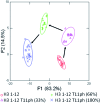Fluorogenic sensor platform for the histone code using receptors from dynamic combinatorial libraries
- PMID: 28451282
- PMCID: PMC5390788
- DOI: 10.1039/c6sc03003c
Fluorogenic sensor platform for the histone code using receptors from dynamic combinatorial libraries
Abstract
Post-translational modifications (PTMs) on histone tails act in diverse combinations in the 'histone code' to control gene expression, with dysregulation observed in a variety of diseases. However, detection and sensing methods are limited, expensive, and/or low-throughput, including MS and antibody based detection. We found that by combining four synthetic receptors developed by dynamic combinatorial chemistry (DCC) in an indicator displacement system, we are able to create a pattern-based sensor platform that can discriminate single PTMs such as methylation and acetylation on a representative histone peptide with 100% accuracy as well as peptides bearing both dimethyl and trimethyl lysine in the presence of arginine methylation, which has not previously been demonstrated, and can even correctly distinguish the position of lysine methylation individually or in the presence of other PTMs. To extend this approach, a full panel of thirteen analytes containing different combinations of PTMs were classified with 96 ± 1% overall accuracy in a 50% left-out analysis, demonstrating the robustness and versatility of the sensor array. Finally, the sensor platform was also used to demonstrate proof of concept for enzymatic assays by analysing the mock reaction of a threonine kinase, successfully identifying analytes representative of substrate conversion both with and without neighboring PTMs. This work provides a rapid platform for the analysis of peptides bearing complex modifications and highlights the utility of receptors discovered though DCC that display variations in binding affinity and selectivity.
Figures










Similar articles
-
Development of "Imprint-and-Report" Dynamic Combinatorial Libraries for Differential Sensing Applications.J Am Chem Soc. 2021 Sep 15;143(36):14845-14854. doi: 10.1021/jacs.1c07068. Epub 2021 Aug 31. J Am Chem Soc. 2021. PMID: 34463091
-
Intricate Effects of α-Amino and Lysine Modifications on Arginine Methylation of the N-Terminal Tail of Histone H4.Biochemistry. 2017 Jul 18;56(28):3539-3548. doi: 10.1021/acs.biochem.7b00450. Epub 2017 Jul 7. Biochemistry. 2017. PMID: 28644004 Free PMC article.
-
Lysine methylation: beyond histones.Acta Biochim Biophys Sin (Shanghai). 2012 Jan;44(1):14-27. doi: 10.1093/abbs/gmr100. Acta Biochim Biophys Sin (Shanghai). 2012. PMID: 22194010 Review.
-
Metabolic labeling in middle-down proteomics allows for investigation of the dynamics of the histone code.Epigenetics Chromatin. 2017 Jul 6;10(1):34. doi: 10.1186/s13072-017-0139-z. Epigenetics Chromatin. 2017. PMID: 28683815 Free PMC article.
-
Proteomic Analysis of Histone Variants and Their PTMs: Strategies and Pitfalls.Proteomes. 2018 Jun 21;6(3):29. doi: 10.3390/proteomes6030029. Proteomes. 2018. PMID: 29933573 Free PMC article. Review.
Cited by
-
AIE-doped poly(ionic liquid) photonic spheres: a single sphere-based customizable sensing platform for the discrimination of multi-analytes.Chem Sci. 2017 Sep 1;8(9):6281-6289. doi: 10.1039/c7sc02409f. Epub 2017 Jun 30. Chem Sci. 2017. PMID: 28989662 Free PMC article.
-
Recent Advances in Design of Fluorescence-Based Assays for High-Throughput Screening.Anal Chem. 2019 Jan 2;91(1):482-504. doi: 10.1021/acs.analchem.8b05303. Epub 2018 Dec 10. Anal Chem. 2019. PMID: 30481456 Free PMC article. Review.
-
Selective discrimination and classification of G-quadruplex structures with a host-guest sensing array.Nat Chem. 2021 May;13(5):488-495. doi: 10.1038/s41557-021-00647-9. Epub 2021 Apr 1. Nat Chem. 2021. PMID: 33795843
-
Sensing of citrulline modifications in histone peptides by deep cavitand hosts.Chem Commun (Camb). 2019 Oct 31;55(88):13259-13262. doi: 10.1039/c9cc07002h. Chem Commun (Camb). 2019. PMID: 31621759 Free PMC article.
-
Parallel Screening for Rapid Identification of Orthogonal Bioluminescent Tools.ACS Cent Sci. 2017 Dec 27;3(12):1254-1261. doi: 10.1021/acscentsci.7b00394. Epub 2017 Nov 15. ACS Cent Sci. 2017. PMID: 29296665 Free PMC article.
References
LinkOut - more resources
Full Text Sources
Other Literature Sources
Miscellaneous

